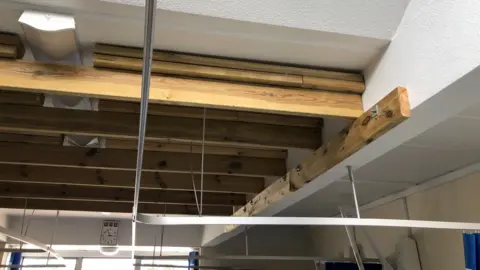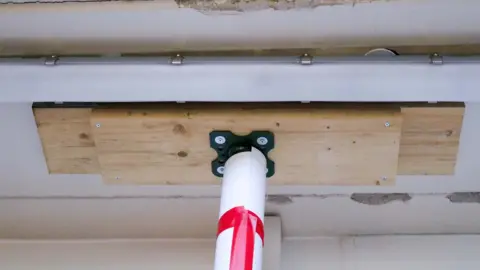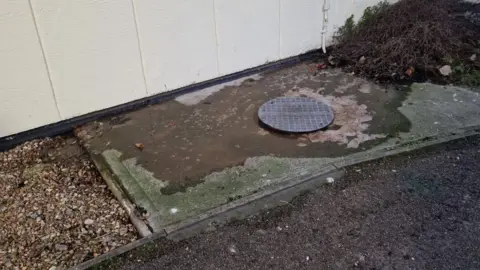NHS crisis: Sewage, floods and rats underscore NHS repair task
 Shaun Whitmore/BBC
Shaun Whitmore/BBCDisrepair in NHS buildings led to thousands of potentially harmful incidents last year including critically ill patients being moved when rainfall came through the ceiling.
Sewage leaks, floods and failing equipment also featured in incident records obtained by the BBC under the Freedom of Information Act.
Health chiefs called on the government to nearly double its capital spending.
The government said "significant sums" had been invested to modernise the NHS.
Heath Secretary Victoria Atkins said the government accepted that some hospital buildings "are not as we would wish them to be" but added that it was for NHS chief executives to decide how to spend the money.
She added: "We cannot direct everything from Whitehall, with the very best of intentions."
According to NHS data, the care of more than 2,600 acute hospital patients was disrupted last year by estates and infrastructure failure.
The BBC asked 210 hospital trusts for examples, and a total of 86 trusts provided a response.
Incidents included:
- Patients awaiting dialysis were sent home because of water supply issues
- Green algae growth in a hydrotherapy pool
- Power lost in an operating theatre
- Sewage leaked into a waiting area for ophthalmology
- Parts of a ceiling collapsed in a clinical area
- An operating theatre reached 29C because of a broken air conditioning unit
The NHS Confederation, which represents trusts, has published a report setting out what health care leaders want the next government to prioritise.
It has called on the government to increase capital spending on the health service from £7.7bn to £14.1bn.
Matthew Taylor, its chief executive, said: "Put simply, a lack of capital funding can leave patients at risk."
Official data shows the total repairs backlog for the NHS was £11.6bn, a rise of 13.6% on the previous year.
In Scotland, earlier this week it was announced plans to build new hospitals, surgeries and a network of treatment centres had been put on hold.
'A rat ran out'
 Rebecca
RebeccaSewage, floods, rats: Disrepair in NHS buildings
Rebecca, 28, and her six-year-old daughter Cleo often have to go to Queen Elizabeth Hospital in King's Lynn.
Cleo's hypoglycaemia - a condition related to low blood sugar - means she sometimes has to stay overnight.
Part of the Norfolk site was built using Reinforced Autoclaved Aerated Concrete (RAAC), a material which forced 100 schools to close last year.
The hospital previously had to close operating theatres because of concerns the ceiling could collapse. All theatres are now back open and the RAAC work is complete.

But Rebecca said staying in the children's ward during the construction was worrying.
"I want to put my whole trust in the hospital," Rebecca said.
"But when I'm in the children's ward and there's a massive beam that's holding the roof up, it does make me worry.
"That's something you don't want to worry about when you're trying to worry about your child's health."
 Rebecca
RebeccaBut the roof was not Rebecca's only concern. She said that in January 2023, she saw sewage leaking on hospital grounds.
"You've got a sterile area and sewage coming out of a manhole cover," she said. "There was building equipment leant up against the hospital wall and a rat ran out from under the building."
A trust spokesman said it worked immediately to clear the blockage.
Director of estates and facilities Paul Brooks said his team was doing its utmost to keep disruption to a minimum.
He said: "We appreciate it can be disconcerting for our patients and visitors when they see building work taking place."
Seriously ill patients moved
Laura - not her real name - works for Colchester Hospital, part of East Suffolk North Essex NHS Trust.
She told the BBC heavy rain caused part of the ceiling on a critical care ward to swell and tiles to bulge.
Laura said no one was hurt, but her colleagues had to move patients to a neighbouring part of the hospital while a clean-up was undertaken.
"We're talking patients on life support, multi-organ failure - and they all had to be moved over to the other side of the unit," she said.
Laura said it was the second time rainfall had come through the ceiling on the ward. She said black aspergillus mould was found, which can cause breathing difficulties.
Nick Sammons, director of estates and facilities at East Suffolk and North Essex NHS Foundation Trust, said keeping patients safe was the trust's "number one priority".
He said: "We took the highest level of precautions and actions possible. This included safely moving patients out of the affected area, deep cleaning and a full assessment of what happened.
"We are also replacing part of the roof to prevent any future incidents."
Trust's £25m annual repair bill
The chief analyst for health think tank The King's Fund, Siva Anandaciva, said the deteriorating condition of some NHS buildings should act as a "wake-up call" for the government.
He said: "Despite pledges to build and refurbish NHS hospitals, the data clearly shows how some NHS facilities are simply not fit for the purpose of delivering modern health care."
Several hospital leaders said they were struggling to maintain ageing buildings, which "predate the NHS" at some sites.
Imperial College Healthcare NHS Trust in London had the largest high-risk repair backlog in 2022-23 at more than £392m. A high-risk repair "must be urgently addressed to prevent catastrophic failure or major disruption to clinical services", according to NHS Providers.
Eric Munroe, Imperial College's director of estates and infrastructure, said: "Much of our estate pre-dates the NHS - some of our buildings are nearly 180 years old."
He said the trust spends £25m annually on the "highest risk maintenance issues" to keep it safe and operating.
He added the only realistic way of properly addressing the maintenance backlog would be a full rebuild of St Mary's Hospital in Paddington.
All three of the trust's main hospitals are included in the Government's New Hospital Programme.
Other trusts also highlighted the age of their buildings.
Leeds Teaching Hospitals NHS Trust said large parts of its sites dated "as far back as Victorian times", while Buckinghamshire Healthcare NHS Trust said it was "delivering 21st century healthcare in 20th century buildings". It faces a £2m annual bill to maintain the tower at Wycombe Hospital, which contains its intensive care unit and operating theatres.
A Department of Health and Social Care spokeswoman said the government had invested "significant sums to upgrade and modernise NHS buildings" including £4.2bn this financial year.
She added: "Trusts are responsible for prioritising this funding to maintain and refurbish their premises, including the renewal and replacement of equipment."
Additional investment of over £20bn for the New Hospital Programme is expected, alongside nationally funded infrastructure improvements in mental health, urgent and emergency care and diagnostic capacity.
Additional reporting: Paul Lynch, Jonathan Fagg and Alex Homer

Have you been affected by the issues raised in this story? Share your experiences by emailing [email protected].
Please include a contact number if you are willing to speak to a BBC journalist. You can also get in touch in the following ways:
- WhatsApp: +44 7756 165803
- Tweet: @BBC_HaveYourSay
- Upload pictures or video
- Please read our terms & conditions and privacy policy
If you are reading this page and can't see the form you will need to visit the mobile version of the BBC website to submit your question or comment or you can email us at [email protected]. Please include your name, age and location with any submission.
